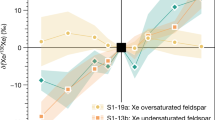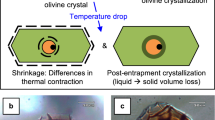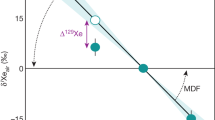Abstract
THE martian atmosphere has a high 129Xe/132Xe ratio compared with any on Earth and most meteorites. The 129Xe/132Xe ratio in the martian atmosphere is also high relative to the martian mantle1. In contrast, Earth's upper mantle has a higher 129Xe/132Xe ratio than its atmosphere2. As 129Xe is the daughter product of the extinct nuclide 129I, a means of fractionating iodine from xenon early in martian history appears necessary to account for the 129Xe/132 ratios of its known reservoirs. Crystal/melt partitioning will fractionate iodine from xenon in the right sense, but the fractionation is probably inadequate in magnitude; differences in the silicate melt solubilities of iodine and xenon would cause fractionation in the wrong direction. Here we present a model to account for the martian xenon data which relies on the very different solubilities of the two elements in water to fractionate them after outgassing. Atmospheric xenon is lost by impact erosion during heavy bombardment, followed by release of 129Xe produced from 129I decay in the crust.
This is a preview of subscription content, access via your institution
Access options
Subscribe to this journal
Receive 51 print issues and online access
$199.00 per year
only $3.90 per issue
Buy this article
- Purchase on Springer Link
- Instant access to full article PDF
Prices may be subject to local taxes which are calculated during checkout
Similar content being viewed by others
References
Ott, U. & Begemann, F. Nature, 317, 509–512 (1985).
Allegre, C. J., Staudacher, T. & Sarda, P. Earth planet. Sci. Lett. 81, 127–150 (1988).
Swindle, T. D., Caffee, M. W., Hohenberg, C. M. & Taylor, S. R. in Origin of the Moon, 331–357 (1986).
McSween, H. Y. Jr Rev. Geophys. 23, 391–416 (1985).
Owen, T. et al. J. geophys. Res. 82, 4635–4639 (1977).
Anders, E. & Owen, T. Science 198, 453–465 (1977).
Dreibus, G. & Wänke, H. Icarus 71, 225–240 (1987).
Musselwhite, D. S., Drake, M. J. & Swindle, T. D. Abstr. 21st Lunar Planet. Sci. Conf., 833–834 (Lunar and Planetary Institute, Houston, 1990).
Hiyagon, H. & Ozima, M. Geochim. cosmochim. Acta 50, 2045–2057 (1986).
Broadhurst, C. L. thesis, Univ. Arizona (1989).
Chen, J. H. & Wasserburg, G. J. Geochim. cosmochim. Acta 50, 955–969 (1986).
Taylor, G. J. J. geophys. Res. (submitted).
Carr, M. H. Nature 326, 30–35 (1987).
Matsui, T. & Abe, Y. Nature 322, 526–528 (1986).
Chemical Oceanography (eds Riley, J. P. & Skinner, G.) (Academic, London, 1975).
Melosh, H. J. & Vickery, A. Nature 338, 487–489 (1989).
Anders, E. & Grevesse, N. Geochim. cosmochim. Acta 53, 197–214 (1989).
Swindle, T. D., Caffee, M. W. & Hohenberg, C. M. Geochim. cosmochim. Acta 50, 1001–1015 (1986).
Hunten, D. M., Pepin, R. O. & Walker, J. C. G. Icarus 69, 532–549 (1987).
Lange's Handbook of Chemistry (ed. Dean, J. A.) (McGraw-Hill, New York, 1979).
Author information
Authors and Affiliations
Rights and permissions
About this article
Cite this article
Musselwhite, D., Drake, M. & Swindle, T. Early outgassing of Mars supported by differential water solubility of iodine and xenon. Nature 352, 697–699 (1991). https://doi.org/10.1038/352697a0
Received:
Accepted:
Issue Date:
DOI: https://doi.org/10.1038/352697a0
This article is cited by
-
Noble Gases and Stable Isotopes Track the Origin and Early Evolution of the Venus Atmosphere
Space Science Reviews (2022)
-
Iodine solubility and speciation in glasses
Scientific Reports (2019)
-
Possible cometary origin of heavy noble gases in the atmospheres of Venus, Earth and Mars
Nature (1992)
Comments
By submitting a comment you agree to abide by our Terms and Community Guidelines. If you find something abusive or that does not comply with our terms or guidelines please flag it as inappropriate.



